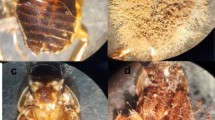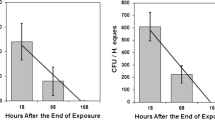Abstract
The environmental toxicology of chemical pesticides have increased interest in the development and use of microbial pest control agents. In the present study four new Brazilian strains of Bacillus and one fungus were tested to evaluate the acute oral toxicity and clearance of these microbials in C57BL6 mice. No mortality was observed after exposure for any of the microorganisms tested. Clearance was significant after 30 days but for one strain of B. thuringiensis and one of B. sphaericus this time was not enough to completely eliminate the spores.

Similar content being viewed by others
References
Alves RT, Silva EAF, Sousa KM, Oliveira MAS, Pereira AV, Pereira EBC, Junqueira NTV, Icuma IM (2003) Controle biológico do percevejo-de-renda da seringueira com o uso de micoinseticida formulado em óleo emulsionável. Embrapa Cerrados, Planaltina, DF, Brasil, p 22. Boletim de Pesquisa e Desenvolvimento, 113. Available on-line in Embrapa Cerrados Electronic Library. http://bbeletronica.cpac.embrapa.br/2003/bolpd/bolpd_113.pdf. Accessed 15 Apr 2008
Bernstein IL, Bernstein JA, Miller M, Tierzieva S, Bernstein DI, Lummus Z, Selgrade MK, Doerfler DL, Seligy VL (1999) Immune responses in farm workers after exposure to Bacillus thuringiensis pesticides. Environ Health Perspect 107:575–582
Brazil (2006) Normative instruction n° 03. Diário Oficial da União, March, 15th, pp 23–25
Cohen Y, Perrone C, Lazard T, Truffot-Pernot C, Grosset J, Vilde JL, Pocidalo JJ (1995) Use of normal C57BL/6 mice with established Mycobacterium avium infectious as an alternative model for evaluation of antibiotic activity. Antimicrob Agents Chemother 39:735–738
Grandgirard D, Steiner O, Täuber MG, Leib SL (2007) An infant mouse model of brain damage in pneumococcal meningitis. Acta Neuropathol 114:609–617
Green M, Heumann M, Sokolow R, Foster LR, Bryant R, Skeels M (1990) Public health implications of the microbial pesticides Bacillus thuringiensis: an epidemiological study, Oregon, 1985–1986. Am J Public Health 80:848–852
Hongyu Z, Ziniu Y, Wangxi D (2000) Isolation, distribution and toxicity of Bacillus thuringiensis from warehouses in China. Crop Prot 19:449–454
Innes DGL, Bendell JF (1989) The effects on small-mammal populations of aerial applications of Bacillus thuringiensis, fenitrothion, and Matacil® used against jack pine budworm in Ontario. Can J Zool 67:1318–1323
Jensen GB, Larsen P, Jacobsen BL, Madsen B, Smidt L, Andrup L (2002) Bacillus thuringiensis in fecal samples from greenhouse workers after exposure to B. thuringiensis-based pesticides. Appl Environ Microbiol 68:4900–4905
McClintock JT, Schaffer CR, Sjoblad RD (1995) A comparative review of the mammalian toxicity of Bacillus thuringiensis-based pesticides. Pestic Sci 45:95–105
Monnerat RG, Silva S, Dias D, Martins E, Praça L, Jones G, Soares CM, Dias JMCS, Berry C (2004) Screening of highly toxic Brazilian Bacillus sphaericus strains against Culex quinquefasciatus and Aedes aegypti. J Appl Entomol 128:469–473
Monnerat RG, Dias D, Silva S, Martins E, Berry C, Falcão R, Gomes AMM, Praça L, Soares CM (2005) Screening of Bacillus thuringiensis strains effective against mosquitoes. Pesq Agropec Bras 40:103–106
Monnerat RG, Batista AC, Medeiros P, Martins E, Melatti VM, Praça L (2007) Screening of Brazilian Bacillus thuringiensis isolates active against Spodoptera frugiperda, Plutella xylostella and Anticarsia gemmatalis. Biol Control 41:291–295
Saik JE, Lacey LA, Lacey CM (1990) Safety of microbial insecticides to vertebrates—domestic animals and wildlife. In: Laird M, Lacey L, Davidson E (eds) Safety of microbial insecticides. CRC Press, Boca Raton, pp 115–132
Siegel JP (1997) Testing the pathogenicity and infectivity of entomopathogens to mammals. In: Lacey LA (ed) Manual of techniques in insect pathology (biological techniques). Academic Press, San Diego, pp 325–336
Siegel JP (2001) The mammalian safety of Bacillus thuringiensis-based insecticides. J Invertebr Pathol 77:13–21
Siegel JP, Shadduck JA (1990) Clearance of Bacillus sphaericus and Bacillus thuringiensis ssp. israelensis from mammals. J Econ Entomol 83:347–355
Silva SF, Dias JMCS, Monnerat RG (2002) Comparação entre três métodos de isolamento de bacilos entomopatogênicos. Embrapa Recursos Genéticos e Biotecnologia, Brasília, Brasil. Circular Técnica 14, p 3. Available on-line in Embrapa Recursos Genéticos e Biotecnologia Electronic Library. http://www.cenargen.embrapa.br/publica/trabalhos/ct014.pdf. Accessed 15 Apr 2008
USEPA (1996) Microbial pesticide test guidelines. OPPTS 885.3050. Acute oral toxicity/pathogenicity. USEPA, Washington-DC, USA. (EPA 712-C-96-315), p 8
WHO (1985) Informal consultation on the development of Bacillus sphaericus as a microbial larvicide. Special Programme for Research and Training in Tropical Diseases, TDR/BCV/SPHAERICUS/85.3, 24 p
Wilcks A, Hansen BM, Hendriksen NB, Licht TR (2006) Persistence of Bacillus thuringiensis bioinsecticides in the gut of human-flora-associated rats. FEMS Immunol Med Microbiol 48:410–418
Yousten AA (1984) Bacillus sphaericus: microbiological factors related to its potential as a mosquito larvicide. Adv Biotechnol Proc 3:315–343
Zhou G, Liu H, He J, Yuan Y, Yuan Z (2008a) The occurrence of Bacillus cereus, B. thuringiensis and B. mycoides in Chinese pasteurized full fat milk. Int J Food Microbiol 121:195–200
Zhou G, Yan J, Dasheng Z, Zhou X, Yuan Z (2008b) The residual occurrence of Bacillus thuringiensis in food and beverages. Int J Food Microbiol 127:68–72
Acknowledgments
We thank SEG-Embrapa for the financial support. Madaí C. Lopes received a fellowship from UniCEUB/PIBIC/CNPq (Brazilian Ministry of Science and Technology).
Author information
Authors and Affiliations
Corresponding author
Rights and permissions
About this article
Cite this article
Oliveira-Filho, E.C., Oliveira, R.S., Lopes, M.C. et al. Toxicity Assessment and Clearance of Brazilian Microbial Pest Control Agents in Mice. Bull Environ Contam Toxicol 83, 570–574 (2009). https://doi.org/10.1007/s00128-009-9817-2
Received:
Accepted:
Published:
Issue Date:
DOI: https://doi.org/10.1007/s00128-009-9817-2




